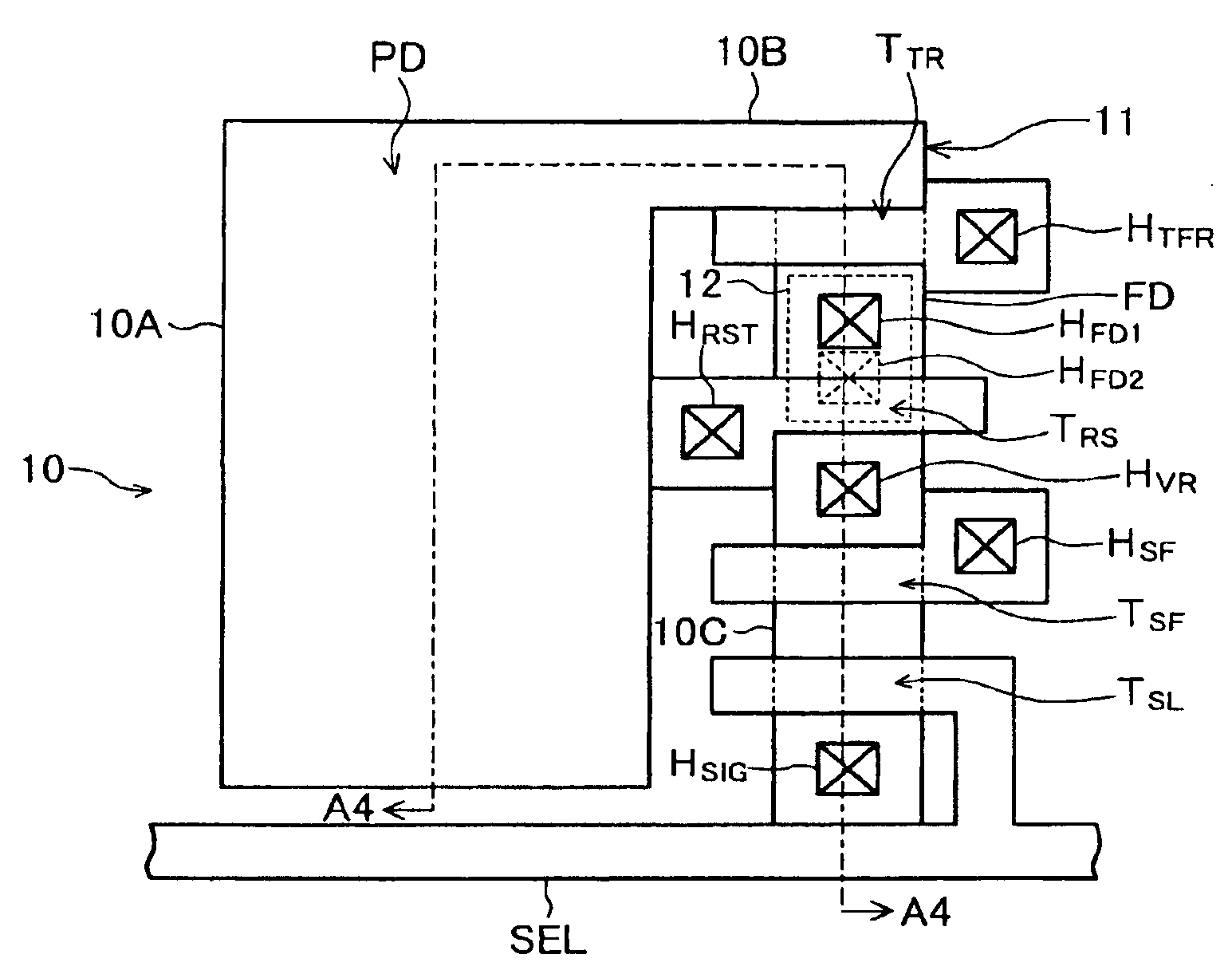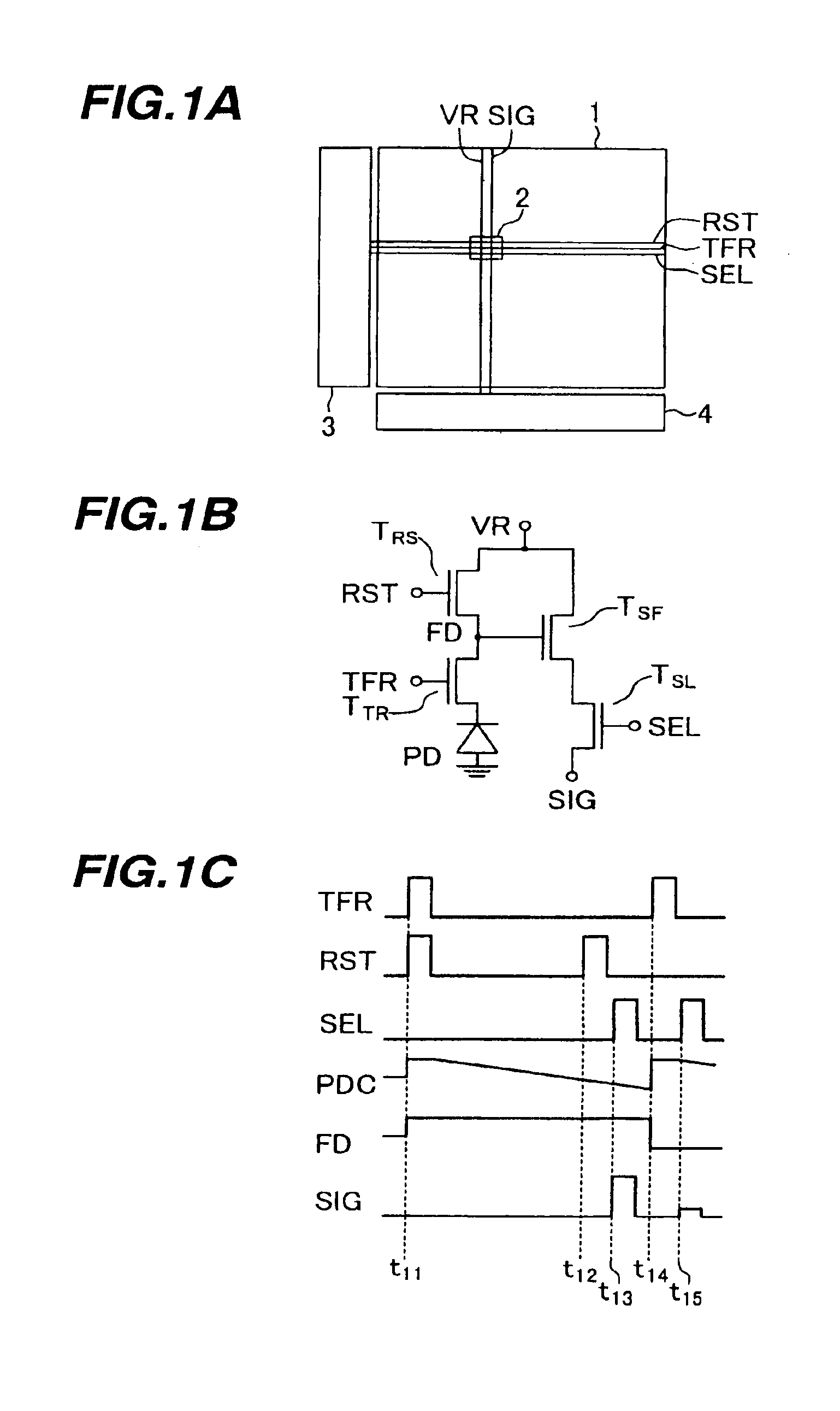Semiconductor device for reading signal from photodiode via transistors
a transistor and photodiode technology, applied in the direction of radio frequency controlled devices, instruments, television systems, etc., can solve the problems of junction leak current reduction, difficult wiring layout, and difficult light convergence of micro lenses, so as to reduce junction leak current and improve image quality
- Summary
- Abstract
- Description
- Claims
- Application Information
AI Technical Summary
Benefits of technology
Problems solved by technology
Method used
Image
Examples
first embodiment
[0033]FIG. 1A is a block diagram of a four-transistor solid state imaging device (image sensor) according to the invention. A plurality of pixels 2 are disposed in an imaging area in a matrix shape. In correspondence with each of pixel rows, a reset signal line RST, a transfer signal line TFR and a select signal line SEL are disposed. In correspondence with each of pixel columns, a signal read line SIG and a reset voltage supply line VR are disposed.
[0034]A row select circuit 3 sends electric signals to the reset signal line RST, transfer signal line TFR and select signal line SEL at timings to be described later. An image signal is input from each pixel 2 to a read circuit 4 via the signal read line SIG.
[0035]FIG. 1B is an equivalent circuit diagram of one pixel. One pixel comprises a photodiode PD, a transfer transistor TTR, a reset transistor TRS, a source follower transistor TSF and a select transistor TSL. These transistors are all made of n-channel transistors.
[0036]The drain ...
second embodiment
[0086]Next, by referring to FIGS. 4A to 4D, a four-transistor solid state imaging device will be described.
[0087]FIG. 4 is a plan view of one pixel of the four-transistor solid state imaging device of the second embodiment. The layout of an active region 10, each transistor, via holes, and a select signal line SEL is similar to the layout of these elements of the solid state imaging device of the first embodiment shown in FIG. 2A.
[0088]FIG. 4B shows the pattern of a silicon wiring layer corresponding to the silicon film 12 of the first embodiment shown in FIG. 2A. An intra-pixel wiring line 15A is connected to a floating diffusion region FD via a via hole HFD1, and to the gate electrode of a source follower transistor TSF via a via hole HSF. A reset signal line RST extending in the row direction is connected to the gate electrode of a reset transistor TRS via the via hole HRST.
[0089]The intra-pixel wiring line 15A and reset signal line RST have a two-layer structure of an amorphous...
third embodiment
[0094]Next, by referring to FIGS. 5A to 6E, a four-transistor solid state imaging device will be described.
[0095]FIG. 5A is a plan view of one pixel of the solid state imaging device of the third embodiment. Description will be given on different points from the structure of the solid state imaging device of the first embodiment shown in FIG. 2A.
[0096]In the first embodiment, the gate electrodes of the transistors and the via holes above the impurity diffusion region are disposed with some position alignment margin. In the third embodiment, as will be later described, via holes are formed in self alignment with gate electrodes. Therefore, the distance between the gates of a transfer transistor TTR, a reset transistor TRS, a source follower transistor TSF and a select transistor TSL is shorter than the distance between the gates of the first embodiment shown in FIG. 2A. Further, via holes HTFR, HRST and HSF for interconnecting gate electrodes and upper wiring layers are disposed wit...
PUM
 Login to View More
Login to View More Abstract
Description
Claims
Application Information
 Login to View More
Login to View More - R&D
- Intellectual Property
- Life Sciences
- Materials
- Tech Scout
- Unparalleled Data Quality
- Higher Quality Content
- 60% Fewer Hallucinations
Browse by: Latest US Patents, China's latest patents, Technical Efficacy Thesaurus, Application Domain, Technology Topic, Popular Technical Reports.
© 2025 PatSnap. All rights reserved.Legal|Privacy policy|Modern Slavery Act Transparency Statement|Sitemap|About US| Contact US: help@patsnap.com



